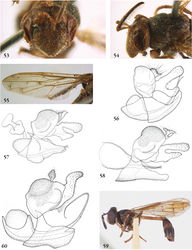Ceriomicrodon
| Notice: | This page is derived from the original publication listed below, whose author(s) should always be credited. Further contributors may edit and improve the content of this page and, consequently, need to be credited as well (see page history). Any assessment of factual correctness requires a careful review of the original article as well as of subsequent contributions.
If you are uncertain whether your planned contribution is correct or not, we suggest that you use the associated discussion page instead of editing the page directly. This page should be cited as follows (rationale):
Citation formats to copy and paste
BibTeX: @article{Reemer2013ZooKeys288, RIS/ Endnote: TY - JOUR Wikipedia/ Citizendium: <ref name="Reemer2013ZooKeys288">{{Citation See also the citation download page at the journal. |
Ordo: Diptera
Familia: Syrphidae
Name
Ceriomicrodon Hull – Wikispecies link – Pensoft Profile
- Ceriomicrodon Hull, 1937a: 25. Type species: Ceriomicrodon petiolatus Hull, 1937: 25, by original designation.
Description
Body length: 11 mm. Very slender, wasp-like flies with long antennae and constricted abdomen. Face convex, somewhat produced on ventral half; narrower than an eye. Lateral oral margins clearly produced. Vertex flat. Occiput ventrally narrow, dorsally somewhat widened. Eye bare; frontally with narrow, horizontal area of enlarged ommatidia at level of antenna. Eyes in male strongly convergent at level of frons. Antennal fossa about 1.5 times as wide as high. Antenna longer than height of head; basoflagellomere more than twice as long as scape; bare. Postpronotum bare. Anepisternum with shallow sulcus; pilose along posterior margin and sparsely anterodorsally, widely bare in between. Anepimeron entirely pilose. Katepimeron flat; bare. Scutellum semicircular; without calcars. Wing: vein R4+5 with posterior appendix; vein M1 perpendicular to vein R4+5; postero-apical corner of cell r4+5 widely rounded; crossvein r-m located around basal 1/3 of cell dm. Abdomen very slender, constricted at tergite 2. Tergite 2 longer than thorax, about as long as tergites 3-5 together. Tergites 3 and 4 fused. Male genitalia: phallus furcate near apex, with dorsal process long and whip-like, ventral process very short; epandrium with ventrolateral ridge.
Diagnosis
Postpronotum bare. Vein R4+5 with posterior appendix. Postero-apical corner of cell r4+5 widely rounded. Abdomen constricted. Tergite 2 longer than thorax.
Discussion
Ceriomicrodon is treated as a subgenus of Microdon by Thompson et al. (1976)[1] and Cheng and Thompson (2008)[2]. However, it does not agree with the diagnosis of Microdon as used in the present paper, because of several characters (e.g. postpronotum bare, abdomen petiolate, phallus with dorsal process long and whip-like). In addition, the phylogenetic results of Reemer and Ståhls (in press)[3] indicate a relationship with e.g. Pseudomicrodon and Rhopalosyrphus.
Diversity and distribution
Described species: 1. Known from Central (Mato Grosso) and Northern Brazil (Roraima).
Taxon Treatment
- Reemer, M; Ståhls, G; 2013: Generic revision and species classification of the Microdontinae (Diptera, Syrphidae) ZooKeys, 288: 1-213. doi
Other References
- ↑ Thompson F, Vockeroth J, Sedman Y (1976) Family Syrphidae. A catalogue of the Diptera of the Americas south of the United States 46: 1-195.
- ↑ Cheng X, Thompson F (2008) A generic conspectus of the Microdontinae (Diptera: Syrphidae) with the description of two new genera from Africa and China. Zootaxa 1879: 21-48.
- ↑ Reemer M, Ståhls G (in press) Phylogenetic relationships of Microdontinae (Diptera: Syrphidae) based on parsimony analyses of combined molecular and morphological characters. Systematic Entomology 38.
Images
|
